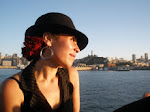I sat down recently with Ana Teresa Fernandez to talk to her about her art. An excerpt of the interview follows.
MW: Have you always been artistic?
AF: It chose me, then I chose it. I started with sculpture in community college, and I liked it, and then the San Francisco Art Institute came down to San Diego, recruiting, and I went by but I didn't know to bring a portfolio or anything, I just came with snapshots of my work and they (the SF Art Inst. recruiters) looked at me like I was crazy. I paint mostly, but I returned to sculpture for Ecdisis.
MW: What inspired you to make Ecdisis?
AF: I like things that straddle, that aren't one or the other or have properties of one thing. I'm drawn to that--I don't consciously choose that. Like in Ecdisis, I used glass because its beautiful and dangerous. It could be right or it could be wrong, depending on perspective.
Like how people choose to see women, either whorish or sexy, mother or pure. Why can't we be it all? I've been working with the tango (in her painting) for a few years, painting women in this very erotic dance, and sexy dresses but doing ordinary chores. I'll keep doing it until the conflict stops for me.
MW: You spent time in Ciudad Juarez, Mexico when you were preparing to make Ecdisis. Are people there on edge all the time?
AF: You have this heightened awareness--the women tell me that they are always expecting something to happen, but you still have to live.
I lived in San Diego and I'd go to Tijuana and party over the border. I was always aware of it, but you live with it and just hope that it doesn't happen to you even though its always happening near you.
MW: How was it growing up straddling the border like that?
AF: I had friends in Tijuana, I went back and forth, I went to Tijuana to socialize. But your language merges into this weird weaving of words and expressions. Thats just a global border thing, though.
MW: Tell me about your painting.
AF: I am constantly reminded of gender. If I paint a female figure, I'm immediately thrown into women's shows, called a feminist. If men paint themselves, they're not immediately called macho, but women--she is always called feminist.
I keep humor in my work. The work takes itself seriously, the hangling of pain is serious.
Thursday, March 26, 2009
Subscribe to:
Posts (Atom)
